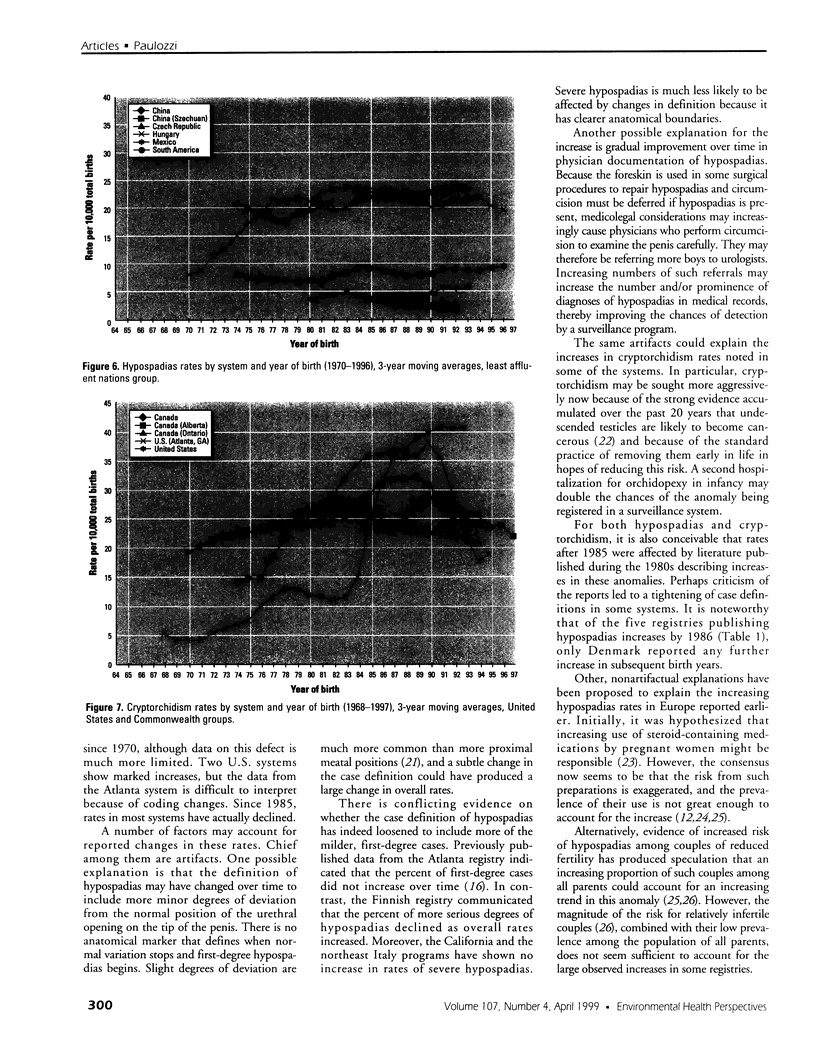Abstract
Researchers from seven European nations and the United States have published reports of increasing rates of hypospadias during the 1960s, 1970s, and 1980s. Reports of increasing rates of cryptorchidism have come primarily from England. In recent years, these reports have become one focus of the debate over endocrine disruption. This study examines more recent data from a larger number of countries participating in the International Clearinghouse for Birth Defects Monitoring Systems (ICBDMS) to address the questions of whether such increases are worldwide and continuing and whether there are geographic patterns to any observed increases. The ICBDMS headquarters and individual systems provided the data. Systems were categorized into five groups based on gross domestic product in 1984. Hypospadias increases were most marked in two American systems and in Scandinavia and Japan. The increases leveled off in many systems after 1985. Increases were not seen in less affluent nations. Cryptorchidism rates were available for 10 systems. Clear increases in this anomaly were seen in two U.S. systems and in the South American system, but not elsewhere. Since 1985, rates declined in most systems. Numerous artifacts may contribute to or cause upward trends in hypospadias. Possible "real" causes include demographic changes and endocrine disruption, among others.
Full text
PDF





Images in this article
Selected References
These references are in PubMed. This may not be the complete list of references from this article.
- Aarskog D. Maternal progestins as a possible cause of hypospadias. N Engl J Med. 1979 Jan 11;300(2):75–78. doi: 10.1056/NEJM197901113000206. [DOI] [PubMed] [Google Scholar]
- Bjerkedal T., Bakketeig L. S. Surveillance of congenital malformations and other conditions of the newborn. Int J Epidemiol. 1975 Mar;4(1):31–36. doi: 10.1093/ije/4.1.31. [DOI] [PubMed] [Google Scholar]
- Carlsen E., Giwercman A., Keiding N., Skakkebaek N. E. Declining semen quality and increasing incidence of testicular cancer: is there a common cause? Environ Health Perspect. 1995 Oct;103 (Suppl 7):137–139. doi: 10.1289/ehp.95103s7137. [DOI] [PMC free article] [PubMed] [Google Scholar]
- Chilvers C., Pike M. C., Forman D., Fogelman K., Wadsworth M. E. Apparent doubling of frequency of undescended testis in England and Wales in 1962-81. Lancet. 1984 Aug 11;2(8398):330–332. doi: 10.1016/s0140-6736(84)92697-7. [DOI] [PubMed] [Google Scholar]
- Czeizel A. Increasing trends in congenital malformations of male external genitalia. Lancet. 1985 Feb 23;1(8426):462–463. doi: 10.1016/s0140-6736(85)91185-7. [DOI] [PubMed] [Google Scholar]
- Czeizel A., Tóth J. Correlation between the birth prevalence of isolated hypospadias and parental subfertility. Teratology. 1990 Feb;41(2):167–172. doi: 10.1002/tera.1420410207. [DOI] [PubMed] [Google Scholar]
- Facemire C. F., Gross T. S., Guillette L. J., Jr Reproductive impairment in the Florida panther: nature or nurture? Environ Health Perspect. 1995 May;103 (Suppl 4):79–86. doi: 10.1289/ehp.103-1519283. [DOI] [PMC free article] [PubMed] [Google Scholar]
- Fichtner J., Filipas D., Mottrie A. M., Voges G. E., Hohenfellner R. Analysis of meatal location in 500 men: wide variation questions need for meatal advancement in all pediatric anterior hypospadias cases. J Urol. 1995 Aug;154(2 Pt 2):833–834. [PubMed] [Google Scholar]
- Giwercman A., Carlsen E., Keiding N., Skakkebaek N. E. Evidence for increasing incidence of abnormalities of the human testis: a review. Environ Health Perspect. 1993 Jul;101 (Suppl 2):65–71. doi: 10.1289/ehp.93101s265. [DOI] [PMC free article] [PubMed] [Google Scholar]
- Giwercman A. Declining semen quality and increasing incidence of abnormalities in male reproductive organs--fact or fiction? Hum Reprod. 1995 Oct;10 (Suppl 1):158–164. doi: 10.1093/humrep/10.suppl_1.158. [DOI] [PubMed] [Google Scholar]
- Jensen T. K., Toppari J., Keiding N., Skakkebaek N. E. Do environmental estrogens contribute to the decline in male reproductive health? Clin Chem. 1995 Dec;41(12 Pt 2):1896–1901. [PubMed] [Google Scholar]
- Källén B., Bertollini R., Castilla E., Czeizel A., Knudsen L. B., Martinez-Frias M. L., Mastroiacovo P., Mutchinick O. A joint international study on the epidemiology of hypospadias. Acta Paediatr Scand Suppl. 1986;324:1–52. doi: 10.1111/j.1651-2227.1986.tb14935.x. [DOI] [PubMed] [Google Scholar]
- Källén B., Castilla E. E., Kringelbach M., Lancaster P. A., Martínez-Frías M. L., Mastroiacovo P., Mutchinick O., Robert E. Parental fertility and infant hypospadias: an international case-control study. Teratology. 1991 Dec;44(6):629–634. doi: 10.1002/tera.1420440605. [DOI] [PubMed] [Google Scholar]
- Källén B., Winberg J. An epidemiological study of hypospadias in Sweden. Acta Paediatr Scand Suppl. 1982;293:1–21. doi: 10.1111/j.1651-2227.1982.tb09577.x. [DOI] [PubMed] [Google Scholar]
- Källén B., Winberg J. Dealing with suspicions of malformation frequency increase. Experience with the Swedish register of congenital malformations. Acta Paediatr Scand Suppl. 1979;275:66–74. doi: 10.1111/j.1651-2227.1979.tb06163.x. [DOI] [PubMed] [Google Scholar]
- Matlai P., Beral V. Trends in congenital malformations of external genitalia. Lancet. 1985 Jan 12;1(8420):108–108. doi: 10.1016/s0140-6736(85)91999-3. [DOI] [PubMed] [Google Scholar]
- Paulozzi L. J., Erickson J. D., Jackson R. J. Hypospadias trends in two US surveillance systems. Pediatrics. 1997 Nov;100(5):831–834. doi: 10.1542/peds.100.5.831. [DOI] [PubMed] [Google Scholar]
- Sharpe R. M., Skakkebaek N. E. Are oestrogens involved in falling sperm counts and disorders of the male reproductive tract? Lancet. 1993 May 29;341(8857):1392–1395. doi: 10.1016/0140-6736(93)90953-e. [DOI] [PubMed] [Google Scholar]












